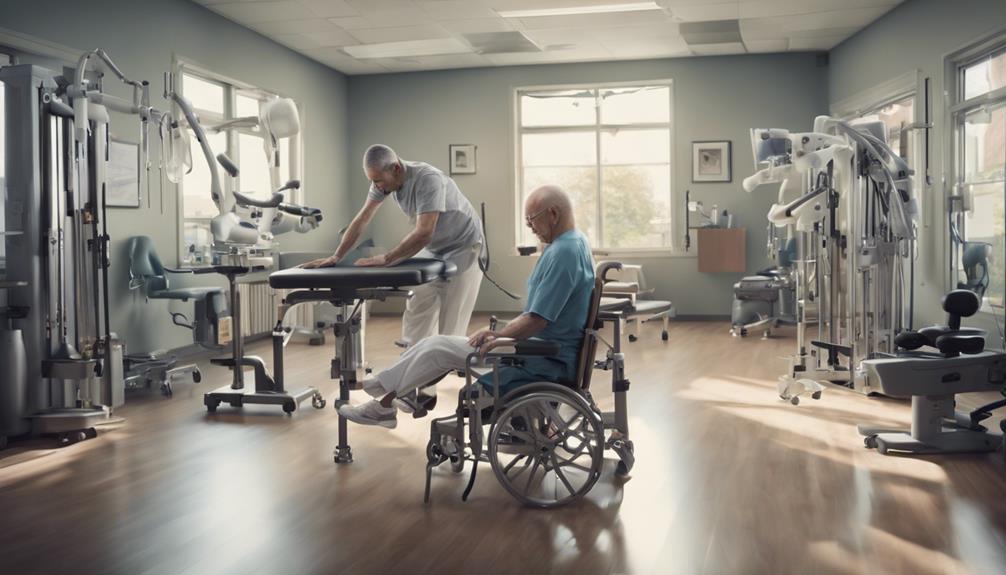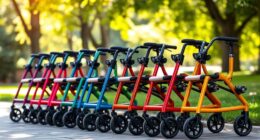When discussing the timeframe for recovering from a stroke in the cerebellum, it is crucial to recognize the diverse journeys of recovery that each individual may go through.
For instance, I recently came across a case where a patient made remarkable progress within the first few months post-stroke, only to face unexpected challenges later on.
Understanding the nuances of recovery duration and the pivotal role of ongoing support and therapy is crucial for a comprehensive rehabilitation journey.
Stay tuned to unravel the complexities and factors that influence the recovery timeline after a cerebellum stroke.
Key Takeaways
- Early dedicated rehabilitation crucial for rapid improvement post-cerebellum stroke
- Customized programs and ongoing therapy vital for sustained recovery progress
- Lack of consistent home therapy beyond 6 months can hinder recovery
- Continued commitment to rehabilitation enhances long-term recovery outcomes
Recovery Timeline After Cerebellum Stroke
Recovery following a cerebellum stroke typically demonstrates rapid improvement within the initial 3-6 months, driven by heightened neuroplasticity. During this crucial period, individuals often experience significant gains in motor function and coordination. Consistent and tailored rehabilitation programs are vital during this phase to maximize recovery outcomes. However, it's essential to note that lack of ongoing home therapy beyond 6 months can lead to plateaus or even regressions in the recovery process. Therefore, dedication to rehabilitation should be sustained even after the initial 6-month period post-cerebellum stroke.
Optimizing recovery after a cerebellum stroke involves customized rehabilitation strategies that cater to individual needs. These programs often emphasize high-repetition exercises to stimulate neuroplasticity and facilitate continued progress. While the initial 3-6 months post-stroke are marked by rapid advancements, ongoing effort and commitment to rehabilitation can yield improvements beyond this timeframe. By adhering to a structured rehabilitation timeline and incorporating consistent home therapy, individuals can enhance their chances of sustained recovery and improved quality of life.
Factors Influencing Recovery Duration

Factors impacting the duration of recuperation post a cerebellar stroke encompass the intensity and consistency of rehabilitation efforts undertaken by the individual.
After an ischemic cerebellar stroke, the recovery duration can vary significantly, with early neuroplasticity leading to rapid improvement within the first 3-6 months.
It's crucial to maintain ongoing personalized rehabilitation programs involving physical therapy, occupational therapy, and speech therapy to optimize recovery time.
Lack of continued dedication to home therapy beyond 6 months post-stroke can hinder progress, potentially causing plateaus or regressions in recovery.
Utilizing tools like FitMi for interactive home therapy can enhance repetition, motivation, and speed of improvement during the recovery period.
Therefore, individuals recovering from a cerebellar stroke should prioritize consistent and intense rehabilitation efforts, including personalized programs and home therapy, to facilitate a more efficient and effective recovery journey.
Expected Recovery Milestones
Upon experiencing a cerebellar stroke, individuals can anticipate a progression of specific milestones indicative of recovery. Enhanced neuroplasticity typically leads to rapid improvement during the initial 3-6 months post-stroke, highlighting the critical nature of this period for progress. Consistent engagement in rehabilitation and therapy is paramount during this time to capitalize on the brain's ability to rewire itself. However, it is important to note that the lack of home therapy beyond 6 months can result in plateaus or even regressions, underscoring the necessity of sustained dedication to rehabilitation efforts. Continued commitment to rehabilitation can yield advancements even after the first 6 months, emphasizing the long-term nature of recovery post-cerebellar stroke. Understanding the potential setbacks and the importance of ongoing progress is vital for individuals and caregivers embarking on this journey.
| Recovery Milestones | Description |
|---|---|
| Initial Progress | Rapid improvement in the first 3-6 months due to heightened neuroplasticity |
| Plateaus and Regressions | Lack of home therapy after 6 months can lead to halts or declines in progress |
| Long-Term Improvement | Continued commitment to rehabilitation can result in advancements beyond the initial 6 months |
Importance of Rehabilitation in Recovery

Promoting neuroplasticity and restoring motor functions, rehabilitation plays a critical role in the recovery process following a cerebellum stroke.
Importance of Rehabilitation in Recovery:
- Enhancing Independence: Consistent rehabilitation efforts can lead to improved recovery outcomes, helping individuals regain independence in daily activities post-cerebellum stroke.
- Tailored Programs for Effective Recovery: Tailored rehabilitation programs, encompassing physical, occupational, and speech therapies, are crucial in addressing the specific post-stroke challenges that individuals with cerebellum stroke encounter.
- High Repetition Exercises for Improved Recovery: Engaging in high repetition exercises within rehabilitation can significantly contribute to enhancing motor skills, coordination, and balance, crucial components for long-term recovery post-cerebellar stroke.
Rehabilitation not only aids in physical recovery but also plays a vital role in the emotional and mental well-being of individuals post-stroke. By participating in tailored rehabilitation programs and engaging in high repetition exercises, individuals can pave the way towards better long-term recovery and an improved quality of life following a cerebellum stroke.
Long-Term Recovery Outlook
Long-term recovery outcomes following a cerebellar stroke can be significantly influenced by the consistency of engagement in tailored rehabilitation programs and personalized recovery plans. Stroke severity plays a crucial role in determining the extent of recovery, with individuals experiencing varying levels of functional improvement over time.
It's essential to maintain rehabilitation consistency beyond the initial 6-month period to prevent stagnation or regression in progress. Ongoing improvement is achievable through dedicated rehabilitation efforts and the implementation of personalized recovery plans that address individual needs.
Monitoring progress and adjusting rehabilitation strategies accordingly are key components in supporting sustained recovery and functional enhancement in the long term post-cerebellar stroke. By committing to rehabilitation interventions and lifestyle modifications, individuals can strive for long-term recovery, highlighting the significance of continuous support and care for those on the path to recovery from a cerebellar stroke.
Frequently Asked Questions
How Serious Is a Stroke in the Cerebellum?
A stroke in the cerebellum can be severe, affecting balance, coordination, and motor control. Symptoms like ataxia, vertigo, nausea, and vision issues may arise, impacting daily life.
The seriousness of the stroke varies based on factors such as the affected area's size and the extent of cerebellar damage. Prompt diagnosis and tailored rehabilitation are key for optimizing recovery outcomes.
Consistent care and support are essential for long-term recovery.
What Is the Mortality Rate for Cerebellar Strokes?
The mortality rate for cerebellar strokes varies, typically falling between 5-10%. This rate is higher when compared to strokes affecting other brain regions. Factors influencing mortality include age, overall health, treatment promptness, and stroke severity.
Swift medical care and rehabilitation can decrease mortality risk post-cerebellar stroke. Understanding potential complications and seeking proper treatment are crucial in improving survival rates for individuals with cerebellar strokes.
What Is the Treatment for a Cerebellar Stroke?
We treat cerebellar stroke with a combination of medications, surgeries for hemorrhages, and rehabilitation therapies like physical, occupational, and speech therapy.
Early rehabilitation post-stroke is vital for maximizing recovery outcomes and improving quality of life.
Multidisciplinary care teams customize treatment plans for each patient's needs and goals.
This comprehensive approach helps promote recovery and independence following a cerebellar stroke.
What Are Good Signs After a Stroke?
Improvement in motor control, balance, coordination, independence in daily activities, and clearer speech are positive signs after a stroke. Improved vision, reduced dizziness, and increased strength also indicate successful recovery. Reduced muscle weakness, enhanced proprioception, and better cognitive function contribute to better memory retention and emotional stability post-stroke.
These outcomes are crucial for enhancing the quality of life after a stroke. They signify the effectiveness of rehabilitation efforts and can lead to improved overall well-being for individuals recovering from a stroke.
Conclusion
Just as a seed needs consistent watering and sunlight to grow into a flourishing plant, so too does the brain require ongoing rehabilitation and support after a cerebellum stroke for optimal recovery.
By nurturing the brain with dedicated therapy and commitment, individuals can cultivate new pathways and abilities, leading to a brighter future filled with growth and potential.
Stay steadfast in your journey towards recovery, and watch as the seeds of progress blossom before your eyes.









